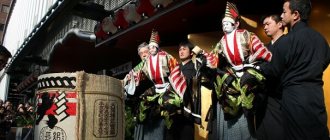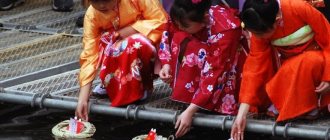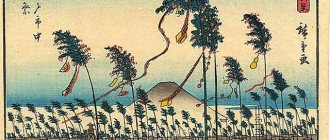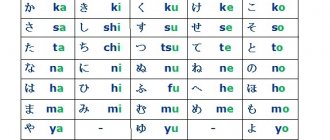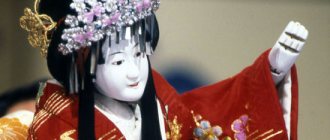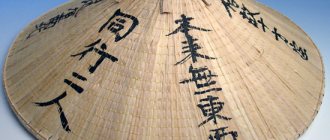JAPANESE WATER DEMON
Like many creatures, mythical and real, kappas do not always look the same. But if you come across a reptile-like creature that walks upright and hangs out in a body of water, you might be dealing with a kappa.
They are the size of a small child or a large ape with humanoid arms and legs. Otherwise, they have characteristics of reptiles or amphibians. They have webbed toes for swimming and may be scaly or slimy. Sometimes they resemble a giant frog or turtle. They usually have something like a turtle shell on their back and a beak on their face.
The Japanese kappa is said to smell fishy and often has a bluish or greenish tint. Japanese parents who want to scare their children shamelessly use his creepy image.
What will always be a special feature, despite numerous variations, is their crown. Looking at their images, you might momentarily wonder why this creature has a European monk's haircut with a frill around its bald head. Take a closer look and you will see that the “bald spot” is actually a small dish (depression) of water. This cavity is surrounded by tight and short hair.
It is believed that youkai derive incredible strength from this feature, but also show their weak point. Keep an eye on this because it will be crucial for your upcoming lesson on Defense Against the Kappa .
Another, most consistent feature of kappas is their favorite food. They love eggplants and some plants of the pumpkin family: melons, zucchini and especially cucumbers.
The remains of a Japanese merman killed nearly 200 years ago are on display in Japan.
The mummified remains of a kappa - a Japanese merman - became exhibits at an exhibition in Japan, which opened at the residence of the Shimazu family in Miyazaki Prefecture on the island of Kyushu (Miyakonojo Shimazu Residence in Miyazaki prefecture on the island of Kyushuu). They show part of an arm about 15 centimeters long and an 8-centimeter part of a leg of a creature that, according to numerous eyewitnesses, is found in Japanese and Chinese rivers and lakes. But just as elusive as the “bigfoot” who lives in forests and mountains.
The remains of a kappa, a Japanese merman. The hand is to the right, looks larger than the leg.
The creepy exhibits are owned by members of the Shimazu family, whose ancestors shot a kappa back in 1818, lying in wait for him on the shore of a reservoir. Demonstrated for the first time in the world.
Kappa - aka “river child” - seems to be small in stature - about the size of a 10-year-old child. According to descriptions, it looks like a frog and a turtle at the same time. The skin has a frog-like texture and color - from gray, green to blue. On the back and chest there is a turtle shell. Like the Teenage Mutant Ninja Turtles. The head is covered with hair, on the crown there is a depression like a saucer, which is filled with water. Instead of a nose there is a beak. The fingers are connected by swimming membranes. It smells like fish. And the most exotic feature is that for some reason the mouth guards have three anus.
Kappa, drawn by an eyewitness in 1801.
Descriptions of mouth guards are found in various Japanese sources.
In some places there are kappas that look like monkeys. Or “snow people” of a traditional appearance, but small in stature - without shells, with fangs, all covered with hair. But also with three anuses.
According to some legends, kappa is just a naughty guy who loves cucumbers and sumo wrestling. According to others, it is a dangerous creature that drags people to the bottom and takes out their entrails.
Evil kappas attack people: a modern illustration from a Japanese book about local monsters
Nowadays, kappa is considered the deity of water, a water demon - a cute creature that protects nature and protects water bodies from pollution.
In some illustrations there are female kappas, but in mythology they are exclusively male. Eyewitnesses reported that these males, despite their small stature, are very eager for earthly women: they attack and rape, although they have impressive “manhood.”
According to modern ideas, kappas live in families
If you believe the legends, then the remains that are now on display at the exhibition are not the only ones. In 1801, another kappa was caught in Chiba Prefecture, Japan. Someone depicted him directly from life.
Like the Bigfoot, kappas are studied by cryptozoologists who believe in both. They believe that myths are not born out of nowhere.
Cryptozoologists are simply objected to by zoologists who believe: the legends about kappas are provoked by encounters with giant salamanders - “hanzaki” - extremely aggressive lizards reaching a length of 170 centimeters.
Giant Japanese salamander. Perhaps this amphibian provoked the emergence of legends about kappas.
By the way, it is not at all impossible that kappas - shaggy-looking - once lived in Russia. They were called mermaids and sat on the branches. They were even seen. About the search for our forest kappas, read “Monkeys have been found in Rus' since ancient times.”
Our Russian merman: drawn from eyewitness descriptions
WHERE KAPPA CAME FROM
This 19th century netsuke expresses the basic features of a kappa.
His scaly short arms and sharp long claws were once feared by all. The name "kappa" means "child of the river", and in English translation it is often called "water spirit". Regional variations have gone by many different names, including gawappa, kawatarō, suiko (水虎, water-tiger), kawappa, kawako, kawaso...
There was once a big difference between the east and west of Japan. People's lives and stories differed. Reptilian mermen, with the shell of a turtle and the beak of a bird, were believed in the east, and kawataro (川太郎, “river boy”), hairier and more ape-like, were believed in the west.
By the nineteenth century, the Eastern Kappa appear to have supplanted their Western counterpart. Modern depictions of kappa tend towards this direction.
There are several theories about the origin of the kappa. Some date back to the practice of floating dead children down rivers and streams, while others suggest the name comes from a "garment" used by Portuguese monks who arrived in Japan in the 16th century.
The most realistic versions of the origin of the appearance of the “river boy” are based on animal species: monkeys, turtles and the now extinct Japanese river otter. The river otter was about 60 centimeters long and nocturnal, so when you look at it standing on its hind legs in the middle of the night, combined with the features of other creatures that you now know are often found in the dark watery depths, you really can see an evil monster. The otter is certainly a likely prototype for the hairy aquatic cavataro.
Monkey Spa Hot Springs in the heart of Hell Valley.
Another possibility is that the kappa's appearance is based on the Japanese giant salamander. As far as I can tell, this theory dates back to a 2012 TV show. But having seen how aggressively this otherwise slow-moving, globular aquatic creature stalks its prey in documentaries, I find it quite plausible.
The simplest theory is that people actually saw a living kappa. You will have to decide this for yourself.
Japanese mythology in Naruto
When creating Naruto, Masashi Kishimoto based the lore of his universe on the myth of the kitsune, as well as several other traditional Japanese myths. Naruto is a jinchuuriki - a person who has a kitsune sealed within him named Kurama. In mythology, the number of tails a kitsune has is correlated with its age, wisdom and strength. Masashi uses this aspect of the myth to visually symbolize how powerful each tailed beast is. The nine-tailed fox inside Naruto is considered the most powerful of them all.
The rest of the tailed creatures were also inspired by various mythical creatures, for example Shukaku was inspired by tanuki - these are dog-like raccoons that were werewolves. However, unlike the same kitsune, tunaki are devoid of any negative connotation and bring good luck in the production of good sake. Tanuki themselves were also used by Isao Takahata in his anime Pom Poko, where they fought against deforestation.
The two-tailed beast, Matatabi, is inspired by bakeneko, a type of cat-like youkai and nekomatama. Any cat that lived more than 30 years could become bakeneko. They could walk on two legs, create fireballs, and also transform into their owner after eating him. They could also revive the dead simply by jumping over.
The four-tailed beast Son Goku is inspired by the Monkey King from Chinese mythology, who was born from a magic stone. He is a skilled fighter, capable of defeating the greatest warriors of heaven. Each of his hairs was capable of becoming a clone of the Monkey King, or transforming into various animals, weapons, or other objects.
The eight-tailed beast, Gyūki, is a combination of an ox and an octopus. It is named after the monster from Japanese folklore, Ushi-Oni. These are demons that live near the coastline and feed on sailors.
Besides the tailed ones, Kishimoto also based the mythology and techniques of the Uchiha clan. Itachi was one of the most powerful users of the Sharingan, and possessed three powerful techniques: Susanoo, Amaterasu, Tsukuyomi - all named after gods from Shintoism.
Only two techniques, Amaterasu and Tsukuyomi, are based on mythology, while Susanoo is a free interpretation of the author. All three are three divine children born of the god Izanagi. Tsukuyomi, the moon god, was born from drops of water after Izanagi washed his right eye during a purification ritual. In Naruto, Tsukuyomi is an illusion technique where the victim becomes its prisoner and goes crazy. Amaterasu is Tsukuyomi's sister and wife, and she is the sun goddess. Amaterasu and both of her brothers are said to have created ancient Japan. In Naruto, Amaterasu is the highest level fire element jutsu that creates black flames that cannot be extinguished.
Susanoo in mythology is the god of the sea and thunder, while in Naruto it is a technique when a person’s body is covered with armor in the form of a samurai.
DANGER KAPPA
I think it's fair to say that the big three youkai are kitsune, tanuki, and kappa. The first two are basically real animals, and their ability to cause chaos is largely based on their shape-shifting abilities. Kitsune and tanuki can pretend to be something or someone else and cause supernatural problems. But a kappa is a completely different matter. They are not completely mismatched with any non-magical animals, and they don't have to pretend to be anything else. They are dangerous in themselves.
Kappa live in water, but we don't. This gives them an advantage and a weapon since we cannot breathe this substance. They are strong for their size (7-10 year old) and can pull people into the water and hold them until they drown.
Although modern kappa are often portrayed as cute and largely harmless, during the Edo period they were monsters who had a particularly brutal method of killing their victims.
In the past, they have even tried to drown horses and cattle, despite the size difference (though they are less successful at this than with humans). Children were often warned about mouthguards so that they would not swim in dangerous bodies of water. Even now you can see kappa on signs like the one above. Skeptics may even decide that this is precisely the purpose they were invented for. In a way, they seem to embody the dangerous and dark aspects of the water element.
Shinigami
Probably another most common Japanese image from myths in anime is the shinigami, or guide of souls. They are a central or at least an important part of such anime as Death Note, Soul Eater, Bleach, Yu yu hakusho.
Shinigami were the gods of death in Japanese mythology. They are described as demons, fallen angels, or even death itself. In Buddhism, a Shinigami is a demon that possesses people and makes them want to commit suicide. They also decided which people would die and which would not.
In Bleach and Soul Eater we are shown characters who are responsible for human souls after death. In Bleach, Shinigami are called "Soul Reapers" and are tasked with protecting people from evil spirits called Hollows and guiding the dead to the afterlife. In Bleach, Shinigami have their own military hierarchy with lieutenants, captains, and a chief Shinigami.
Soul Eater is a more free interpretation and there students of the Academy of Death must kill 99 evil human souls and one witch soul in order to awaken a powerful weapon known as the “Death Scythe”.
In Yu yu hakusho, the main character dies while saving a boy, after which he is made into a spiritual detective who must fight demons.
But probably the most famous image of Shinigami was in Death Note. There they were gods of death who spent eternity in their world, killing people from time to time to prolong their lives.
These are just the most famous images of Japanese mythology in anime, and there are actually many more.
KNOW YOUR KAPPA
There's a magic ball in your ass and the kappa wants it. In some stories, the kappa does not reach for the butt with its hands, but instead sucks the shirikodama from the body.
Kappa aren't just weird and dangerous. They're kind of perverted. Water spirits don't want to drown you just like that. They pursue the victim because they want to get your shirikodama 尻子玉しりこだま. This is a ball that is supposedly located inside the human anus. It is said that the origin of stories about shirikodama comes from the exposed anus of drowned people.
The kappa supposedly reaches into your ass with its hand to get that precious element or suck it out. And if it doesn't kill you, you'll still drown.
What is this thing? Some say it is the physical form of the Japanese human soul. We think that if there is such a thing as a soul, this is not where we would prefer to store it. Another idea is that it is a Buddhist hojo, a kind of bulb-shaped gemstone that grants wishes.
A plausible theory is that the shirikodama is actually the liver, or is simply preventing the removal of the liver, which the kappa is actually after.
Kappa's obsession with our nasties leads them to hide in closets and try to fondle women's buttocks. But if that's all that happens, you'll get off easy: there are eyewitness accounts of Kappa raping women and leaving them pregnant with deformed children. Most of these children were killed at birth, although this tale from The Legends of Tono tells of a man who had a better idea:
In one poor family from the village of Kamigo, a child was born that looked like a kappa. There was no definitive evidence that it was a water spirit, but it had bright red skin and a large mouth. He was truly a disgusting child. Hating the child and wanting to get rid of him, the family left him at a crossroads. Very little time passed, and they decided that they could make a lot of money by showing the “water demon” or selling it to a traveling circus. When they returned for it, it had already hidden itself, and no traces were visible anywhere.
Kappas from Sarazanmai
There are many ways to look at Kunihiru Ikuhara's anime, but the fact is that his latest anime, Sarazanmai, is based on the legend of the kappa.
Kappas in Japanese mythology are a cross between a frog and a turtle with a saucer on top of their head that gives them mystical powers. The saucer is always filled with water, since this is what their strength depends on. Kappa's favorite food is cucumbers.
In Ikuhara's anime, three schoolchildren break a kappa statue, causing the kappa king named Cappy to transform them into his own kind and force them to hunt for the shirikodama. This is a spirit ball that in Kappa mythology they steal from people through the anus. The Kappas did this as a prank or to give shirikodama as a tax to the Dragon King. But if in myths after this a person became a fool, Ikuhara draws an analogy with cleansing from complexes.
PROTECTION AGAINST JAPANESE KAPA
Japanese merman will not deny themselves the pleasure of indulging in carnal pleasures with women against their will. In addition, river spirits spoil nets, steal fish and lead travelers astray.
Kappa has a couple of weaknesses that you can use against him:
- firstly, he loses his strength if the water bowl on his head becomes dry,
- and secondly, he is very polite. So if you bow to him, he will be forced to bow back, and that's the trick.
For example, the Japanese kappa are very strong on land and love to challenge people in sumo matches, so for you this is a losing match. But if you bow before the fight begins, the kappa will bow back and spill water. He becomes powerless as water pours out from the cavity on his head.
If a person filled the cavity with water again, it was believed that the kappa would serve him forever as a sign of respect for saving his life.
If you want to try to catch a kappa or kill him, your best bet is to use his worst desires against him. In the picture above, the guy wandering around the river is actually bait: the idea is to lure the kappa and catch him as he goes after the victim's shirikodama . If you have a really brave or stupid friend who is willing to play this role, let us know how it goes.
Some more useful facts: Kappas do not like pumpkin, sesame, ginger and iron. It is said that in some areas eating a cucumber and then swimming in a pond can provoke a kappa to attack, but in other areas it will actually push it away from your shirikodama . Check with locals for advice before trying.
Then know that this creature has an aversion to deer antlers and monkeys. Consider taking them with you before going on the river, it will be safer.
Kappa
Kappa - with all the variety of characters in Japanese demonology associated with water, the most famous is the inhabitant of rivers, a kind of merman - kappa, which means “child of water”. His appearance would fully correspond to this name, if not for his actions. In the minds of the Japanese, kappa was an exclusively male creature. His face is close to that of a monkey, his eyes are round. On the back there is a shell, like a turtle. The legs are similar to those of a frog. On the head there is a special depression in which water splashes. It is this depression that is the place where the power of the kappa is concentrated: if the water flows out of this hollow, the merman loses its power and becomes absolutely helpless. Kappa was considered a very dangerous creature in Japan, which made its living by luring or simply dragging people and animals into the water. It was customary to say about those who accidentally drowned that they were dragged away by a kappa, and children were strictly forbidden to play on the river bank. In water, the kappa was truly omnipotent. It is not for nothing that even now in Japan, when they want to emphasize someone’s special talent, they say that teaching this person his own craft is the same as “teaching a kappa to swim.” True, even on the ground the kappa felt quite confident. They said that he comes out of the water in order to steal a melon or cucumbers, a horse or a cow, and maybe even a person. Kappa were believed to feed on the entrails of their victims and also suck blood. The typical image of a kappa, which has developed in folk legends and fairy tales, is that of a thief, usually caught and punished. However, only true brave men could defeat the kappa by force. At the everyday level, all sorts of recommendations were passed down from generation to generation on how to get rid of mouthguards with the help of ingenuity. For example, in northern Japan there was an idea that kappas, despite their cruelty, were very polite. And therefore, when you meet a kappa, no matter how much horror you experience, you must bow deeply to him. Then the mouthguard will answer you in kind, and the liquid will flow out of the cleavage. Another way is to take advantage of the creature's weakness for cucumbers, which it prefers over human flesh. If you write the names and ages of the donor's family members on the cucumber, they will not be in danger from a grateful kappa. And if in a fight with a kappa you tear off his hand (which happens often), then the kappa, who has the ability to “replant” the severed body parts within three days, will come and ask for his hand back. In gratitude for the return of the limb, the kappa may give you the gift of healing, or give you a lot of money. It seems, however, that it would be unfair to consider the kappa as a uniquely harmful creature. Japanese folklore knows many examples of the kappa's shyness and helplessness, its desire to help a person and even make friends with him. In general, the connection between humans and mermen turns out to be very strong.
Sorry, this image does not meet our guidelines. To continue publishing, please delete the image or upload another one.
GAS MASTERS
The coveted "gem" in our butts isn't the only butt-related aspect of the kappa legend. They are also known for being perfect farts. The experts I consulted didn't explain why kappas fart so well, so I can only assume it has something to do with their cucumber-rich diet.
Despite their addiction to their own gases, they cannot tolerate other people's secretions. You can see this in the print above, where it is clear that the kappa cannot tolerate this. This print is an advertisement for a professional fart artist, sometimes called Flatulist, fartist and professional farter (we are not making this up, this is a historical fact).
Obviously, if you live in Japan and want to convince people that you have a talent for flatulence, this is the best comparison.
The idea is that this guy is so good at what he does that he can even beat a kappa at their own game, the thinking went around in the fart performing arts community. There is even a famous saying in Japanese: “farts like a kappa” (a couple of trifles, no big deal). This is often said about a person who does something easily and without visible effort.
You probably won't have as much power as a professional fart player. But if you have problems with your mouthguard and everything else fails, try farting on them.
Along with “farts like a kappa,” there are other sayings and proverbs that mention kappas. It is well known that kappas are very good swimmers, so in Japan they came up with the following expressions:
- "Kappa no kawanagare" or "even a kappa can drown", a warning that even what you know best can be ruined.
- ""kappa no kawa nagare" or "kappa who is carried away by the current", which means that we should not be too sure why even the best make mistakes.
- "Kakappa-hage" is a man with a bald spot on the top of his head.
In Japanese, amagappa 雨合羽かっぱ means cloak, referring to another strange feature of kappas: they need to remove their skin before sleeping (they only sleep on the shore). Without it, they are defenseless and cannot return to the water.
With all this information, you are now well armed against a possible encounter with a kappa during your stay in Japan!
Kappa (mythology)
An image of a kappa reported to have been captured on a beach in Mito, Chiba Prefecture, in 1801. Drawing from an illustrated book of a collection of mythical creatures.
In the Singai River, a Chinese ape-like kappa attacks a child. (1836) Typical habitat is a river or swamp, but there are rumors of sea kappas that drink sake and swim well.
It is believed that the kappa enjoys pranks, but does not harm humans. However, there are also stories about kappa passing near water or bathing people into the water, drowning them, and pulling out a ball (尻子玉) from the person’s anus, which they eat or give to the Dragon King as a tax. This mythical ball
seemed to be a special organ in the anus, when removed, a person became a fool (Japanese 腑抜け lit. “without entrails”).
The basis for the appearance of such a legend could be the fact that the anus muscle of a drowned man relaxes and it seems that a ball was pulled out from there. There is also a hypothesis that this ball
symbolizes the insides as a whole[3].
Also the mouthguard can pull out the ball
from a child if he loses in sumo wrestling. Kappa loves sumo and often enjoys wrestling with human children. It is believed that kappa is stronger than anyone, even an adult sumo wrestler, but there are still several ways to win. If you catch a kappa just after he has eaten an offering to the deceased, then even a child can defeat him. Another way is to bow before the start of the fight: the kappa will bow back, the water will pour out of the saucer, and he will lose strength. Generally speaking, kappa love sumo because it was originally a ritual in honor of the Water Deity.[4]
Favorite food: cucumbers, fish and fruits. The reason for the love for cucumbers lies in the fact that kappa is considered the incarnation of the Water Deity. And it was customary to offer cucumbers to the Water God[5]. Makizushi with cucumbers is called “kappa” (Japanese: カッパ巻き).
Kappas do not like: iron, deer antlers and monkeys. One day, having argued with a monkey who would stay under water longer; The kappa lost after surviving 12 hours, while the monkey lasted 24.
In folklore, there are frequent references to kappa, having a strong sense of duty, bringing fish or prescriptions for medicine as gratitude for a good deed. It is said that if a kappa pats itself on the head with a fern leaf, it can temporarily turn into a human. He can also take the form of a monkey or otter. It is believed that if you catch a kappa, it will grant you any wish. In Kyushu there is a belief that kappa can imitate the sounds of a mountain collapse, a falling tree, an explosion, and even a human song. But, even though the melody of this song will be beautiful, no one will be able to understand its words.
GET GOING WITH KAPPA
They say that kappa sometimes helps people. At least under certain circumstances, a deal can be struck with them. One strange thing about Kappa is that he is supposedly talented in the medical field, making ointments and medicines and setting broken bones. If you tear off your mouthguard's hand (like when he sticks it out of the toilet to pet you), he knows how to reattach it if he gets it back in time. They have been known to teach people their medical secrets in exchange for the return of an arm.
There are stories of farmers interacting with kappas. They say that they fulfilled some of their requests, for example, helping to water the fields.
They can also befriend humans in exchange for gifts and offerings, especially cucumbers, the only food that kappa value more than human children.
This type of youkai-human relationship led to the birth of certain Shinto shrines called Jinja, dedicated to the veneration of these spirits who became benevolent to humans. You can leave cucumbers in them to appease them.
At Sogenji Temple in Asakusa, Tokyo, also known as Kappa-dera, it is said that the area was repeatedly flooded until a group of kappa helped build structures to keep out the water. So now they are revered there. For you skeptics, Sogenji even has a relic to prove it: the mummified hand of a real kappa.
There is another story about kappas and cloaks that is related to the famous Kappabashi Bridge in Tokyo. Apparently, the first Kappabashi Bridge was built by a cloak merchant who hired watermen to do the work. Historians don't know if these were the same kappa who stopped the flood in Asakusa, but anything is possible.
Fairy tales and folk tales about these creatures have survived to this day and have become the basis for cults and holidays associated with them. Legends speak of the peasants' fear of the fire kappa, so some villages hold festivals with bonfires and fireworks every year, with the goal or belief that fire scares away these creatures. Or the warnings emanating from kappa, which to this day appear on the watercourses of some Japanese cities and villages .
MODERN JAPANESE KAPPA
Like many other youkai, such as tanuki, kappa are often more cute than scary these days. Once upon a time in the 20th century, they were frightening “outsiders.” In stories about the kappa, they were contrasted with humans.
In the 1960s, Mizuki Shigeru drew the manga Sanpei Kappa, where he described the kappa as an absolutely adorable creature, with almost the same face as his scary human friend.
Sanpei Kawahara is a boy who goes to live with his grandfather in a mountain town. His mother lives in Tokyo, working at a pachinko parlor to eventually send Sanpei to college. At school, his classmates make fun of him for looking like a kappa. One day while sleeping on a boat, a group of Kappa find Sanpei, mistake him for one of their own, and bring him back to Kappa Country. The Kappa have a rule to kill all people who wander into their country, but since Sanpei is like one of them, they decide to make an exception and let him live. He is allowed to return home on the condition that he takes care of the son of the elder Kappa Kanpei, who is studying abroad in the human world.
Kappas are now used in advertising and as logos. There are cute stationery with these characters, emblems, keychains, toys and local delicacies like these buns:
Ironically, their image can now even be used to invite visitors to an onsen, which was the worst idea in the old days:
In the 1970s, in rural revitalization projects and festivals, the kawaii (cute) kappa became a symbol, playing on its association with nature and the disappearing rural way of life.
Although it is still used in no-sailing signs, some of them read more like friendly advice than a threat. They are also used in posters encouraging people not to litter and in campaigns to protect the environment, including clean water.
Nowadays, it seems that the kappa is in the same danger as it once was the personification of the dangers of nature. It is now used as a symbol of the pristine nature that we must protect. As Michael Dylan Foster puts it, "youkai, which once represented the violence and unpredictability of the natural world, and especially water, have now literally become the poster child for efforts to stop the sacrifice of nature."
However, as this quote suggests, nature has a lot to be angry with us for... so if you do encounter a kappa, you better take care of it because it might get angry.
Views: 828
Share link:
- Tweet
- Share posts on Tumblr
- Telegram
- More
- by email
- Seal
Liked this:
Like
